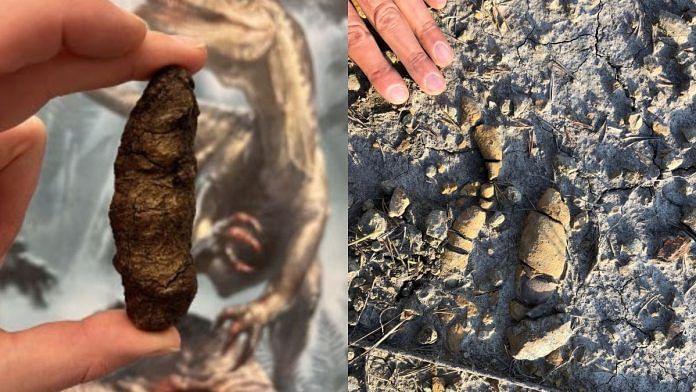New Delhi: Dinosaur droppings and vomit have helped a group of Swedish paleontologists and others uncover the long-hidden secret of how the reptiles evolved over 30 million years to establish dominance of their ecosystems in the early Jurassic Period.
By analysing well-preserved ancient dinosaur faeces called coprolites and fossilised remains of undigested food or bromalites, the researchers recreated the eating habits of tetrapods from the Late Triassic—when early dinosaur ancestors first emerged—to the beginning of the Jurassic Period, when they replaced other non-dinosaur land animals.
The study, published in Nature Wednesday, was conducted by paleontologists from Sweden’s Uppsala University in collaboration with experts from Norway, Poland, and Hungary.
“Studying undigested food remains and piecing together ‘who ate whom’ in the past is true detective work,” said Martin Qvarnström, the study’s lead author in a statement. “The ability to examine what animals were eating and how they interacted with their environment provides invaluable insights into what enabled dinosaurs to reach supremacy.”
While much is known about how dinosaurs lived and went extinct, little had been explored so far about how they assumed control in the first place. In this study, researchers developed a five-step model that sheds light on how these ancient reptiles rose to power and reshaped the natural world around them.
Also Read: Extinct elephant genus lived in Kashmir over 300,000 yrs ago. Humans made tools from their bones
Tracing evolution via dietary preferences
To understand the rise in abundance and diversity of dinosaur species nearly 200 million years ago, the authors analysed over 500 fossilised samples revealing their eating behaviours. These samples, including faeces, vomit and undigested food found in their intestines, were collected from specific sites in the Polish Basin.
“Our research is innovative, we decided to understand the biology of early dinosaurs from the perspective of their dietary preferences,” said Grzegorz Niedźwiedzki, senior author of the study.
Qvarnström and his colleagues used a range of advanced techniques to analyse and explore these pre-historic food remains. These included optical and scanning electron microscopy for detailed assessment of thin sections, chromatographic and mass spectrometric methods to identify and isolate the plant traces, and synchrotron microtomography—a powerful technology that creates 3D images of internal structures within the fossils.
The authors discovered that the food remnants in these samples were diverse—fish, insects, remains of larger animals, a significant amount of plant matter and even charcoal in some large plant-eating dinosaurs.
By combining coprolite and bromolite data with existing records of dinosaur bite marks, footprints, bones and plant and climate data of the period, the team pieced together a detailed view of Triassic and Jurassic ecosystems and developed a step-by-step model of dinosaur evolution.
These fossil examinations highlight that the first step was the appearance of early dinosaur ancestors at least 230 million years ago. They ate both plants and meat. Over time, these species evolved into the early herbivorous and carnivorous dinosaurs, which gradually outcompeted other species during the middle of late Triassic period.
Towards the end of the Triassic period, volcanic activity likely caused environmental changes, creating a wider variety of plants. This supported the growth of larger plant-eating dinosaurs, which then led to the rise of bigger meat-eating dinosaurs. By the start of the Jurassic period, dinosaurs had taken over as the dominant animals in their ecosystems.
According to the authors of the study, the findings remain relevant today, as climate change is drastically disrupting environmental conditions, offering valuable lessons for the survival of species.
“By studying ecosystem responses of the past, we gain essential insights into how life adapts and thrives during shifting environmental conditions. What to do to not die out,” added Niedźwiedzki.
(Edited by Mannat Chugh)
Also Read: Chinese scientists see sweet success, reverse type-1 diabetes in woman using her own stem cells






